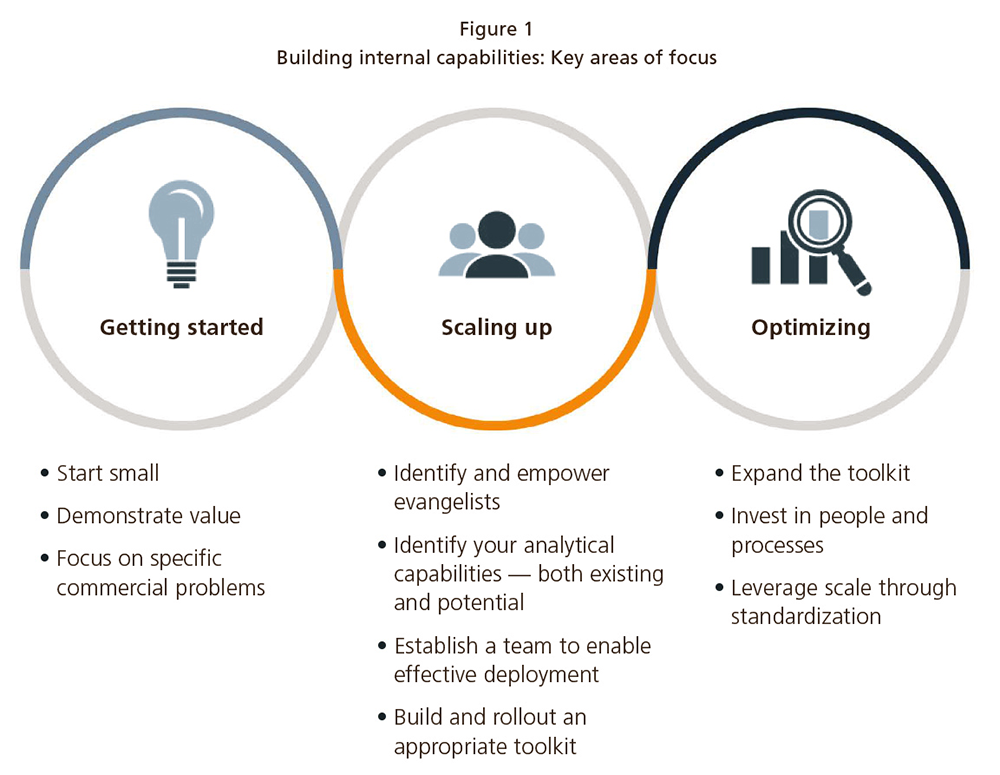 Tom Diplock, Partner and Head of Data & Analytics, Phillip Meier, Principal and Stuart Robertson, a manager at L.E.K. Consulting, say that the use of data analytics in your company should not be the preserve of a handful of experts – it should be available to everyone to benefit the whole business.
Tom Diplock, Partner and Head of Data & Analytics, Phillip Meier, Principal and Stuart Robertson, a manager at L.E.K. Consulting, say that the use of data analytics in your company should not be the preserve of a handful of experts – it should be available to everyone to benefit the whole business.
Data and analytics professionals are at the centre of the next big race for talent. In 2015, there was a surplus of people with data science skills. Now there’s a significant shortage.[1] By 2020, IBM expects demand for data and analytics talent to reach 2.7 million positions in the US alone.[2]
The competition for talent will be especially intense for companies for whom advanced analytics forms a core part of their proposition – think e-commerce giants, hedge funds and complex system engineers. For them, a dedicated, in-house team of data specialists can be a necessity.
But the rest of us? Not so much. Consider the findings of a Rexer Analytics survey,[3] in which more than a third of data analytics professionals reported that their company never, or only sometimes, puts their analyses to use. This calls into question the practicality of funnelling analyses through centralised teams focused on big-picture challenges.
Complete integration with the business
Most companies don’t need a small army of data scientists or bleeding-edge analytical techniques. What they do need are analyses that solve key commercial and operational problems. The good news is that the tools to do so are readily available, and relatively inexpensive. What’s missing, more often than not, is a clear strategy and operational model for using these capabilities in ways that are specific to the company’s business requirements. Any such effort depends on three basic components:
- People who can combine their commercial expertise with advanced analytics methods and applications in an effective way;
- An evidence-based approach that translates analytical know-how and an understanding of the business problem into actionable insights; and
- A small team of analytics professionals (not necessarily data scientists) to develop appropriate analytical tools and techniques and enable the organisation to deploy them through internal training and advice.
Together, these form a solid foundation for closing the gap between technical skills and commercial thinking so that businesses can extract value from analytics.
Building internal capabilities
So how to get started? It is advisable to take your cue from companies that have already started on this journey (see Figure 1).

Getting started
Start small and demonstrate value: Aim for a single, key problem or an important (but limited) area of the business where analytics can have a valuable and immediate impact, then use the results to build credibility, excitement and momentum.
Brewing and beverage company SABMiller, (now a division of Anheuser-Busch) took this track when they decided to make data and analysis available to their business units. To manage risk, they kept their initial investments modest. That way, they could readily abandon any failures while expanding the rollout of the tools and approaches that worked.
Focus on specific commercial problems: Tie analytics to the commercial and operational heart of your organisation (if it doesn’t address a core business need, analytics can be a hindrance more than a help). While you’re at it, place the analytical capability as close as possible to those doing the commercial thinking.
Scaling up
Identify and empower evangelists: Don’t leave business users to figure out the commercial value of analytics on their own. Show it to them instead, via a network of advocates across the organisation. Through these advocates, companies can proactively introduce the capabilities available to the business and provide expert support for those finding their way.
That’s what UK supermarket Sainsbury’s did when they created a new 60-strong internal team called the Humanalysts.[4] The group’s mission? To identify data-driven opportunities for improvement—such as predicting shoppers’ responses to new pricing strategies—and, along the way, make believers out of often skeptical business users.
Identify your analytical capabilities – both existing and potential: Many companies already have functions dedicated to strategy, financial planning or business insights, as well as individuals who use analysis to solve business problems. Build on these assets by empowering them with new capabilities.
When Jaguar Land Rover discovered pockets of self-service analytics activity across its departments,[5] the company began offering in-house analytics training. The first 60-seat course was filled to capacity. By last year, an estimated 1,800 to 2,500 employees had become “citizen analysts” – business users who created their own analytics as part of their day-to-day work.
Establish a team to enable effective deployment: Building a small team of analytics professionals will help to ensure the effective deployment of analytics across the business. This team does not need to be comprised of data scientists – just individuals who are interested in and capable of developing appropriate analytics tools and techniques, and championing them across the organisation (helping to provide internal training and advice to employees).
Build and rollout an appropriate toolkit: Encourage business users to tap into analytics with self-service tools that preclude the need to learn how to code. The most effective of these have built-in algorithms to navigate company data, create charts and dashboards, and deliver insights to different audiences.
Nike put together a tailored set of software tools for business intelligence, analysis and visualisation – all with an aim of reducing technical barriers and bringing insights to users in the business.[6] The toolkit had to cover the full range of user requirements, from those just wanting key dashboards to those looking for as much data as possible to perform their own ‘exploratory’ analysis. All users benefit from a central team that provides the governance necessary to ensure a stable, secure and up-to-date environment.
Optimising
Expand the toolkit: As more use cases are identified, it will be necessary to expand the analytic toolkit and the range of techniques used. It is important to retain the agile spirit and desire to experiment from earlier in the journey. Some of the new tools and techniques will work well, but a 100 per cent success rate is unlikely. Assuming sensible, low cost experimentation, a two-thirds success rate on 15 opportunities is better than a 100 per cent success rate on two.
Invest in people and processes: Now is the time to ensure sustainability. This can be achieved by investing in processes that are fit for the longer term and provide clarity on future career paths and opportunities for the core enabling team.
Leverage scale through standardisation: As the level of adoption (and business benefit) grows, there are opportunities to leverage economies of scale. Examples of this include securing better licensing deals for software, increasing utilisation of key analytic resources (both people and hardware) and maximising efficiency (rather than expediency) of workflows as usage becomes more consistent.
Making use of what you have
Wherever you start your journey, keep this in mind: democratising analytics is an unavoidably iterative process. Every step requires a look back to ensure the appropriate controls, training and delivery mechanisms are in place and working the way they need to be. As Voltaire famously observed, with great power comes great responsibility.
It’s also a good idea to borrow liberally from those in similar situations to your own. Make generous use of relevant case studies. Prioritise the insights that generate commercial benefits. When reporting back within your organisation, focus on output and impact rather than the underlying analytics. Inspire, and be inspired.
Finally, don’t give in to pressures to build great teams of scarce, highly-paid specialists without working out what makes sense for your business. There’s nothing so special about analytics that it must be kept from those most intimately familiar with the problems you need to solve, and who work for you already. Analytics should inherently empower anyone with the means to comprehend it. Put another way: data analytics is for everyone – not just the few.
L.E.K. Consulting is a management consulting firm headquartered in London (UK). The company’s primary service lines consist of corporate strategy, mergers and acquisitions, and operations. It employs a generalist model across all major industries, including a large presence in defence, aviation, life sciences, healthcare, energy, entertainment, transport, retail, consumer products and financial services.
[1] LinkedIn Workforce Report | United States, LinkedIn, 10th August 2018, viewed 29th January 2019, <https://economicgraph.linkedin.com/resources/linkedin-workforce-report- august-2018>
[2] The Quant Crunch: How the Demand for Data Science Skills is Disrupting the Job Market, IBM, August 2017, viewed 29th January 2019, <https://www-01.ibm.com/common/ssi/cgi-bin/ssialias?htmlfid=IML14576USEN&>
[3] 2017 Data Science Survey, Rexer Analytics, 2017, viewed 29th January 2019, <http://www.rexeranalytics.com/data-science-survey.html>
[4] Here’s How Sainsbury’s is Using Big Data to Drive Customer Experience, eTail Europe, viewed 29th January 2019, <https://etaileurope.wbresearch.com/sainsburys-big-data-customer-experience-strategy-ty-u>
[5] Carey, Scott, Jaguar Land Rover turns to Tableau to give staff analytics dashboards that “just work”, Computer World UK, 21st March 2017, viewed 29th January 2019, <https://www.computerworlduk.com/data/jaguar-landrover-turns-tableau-give-staff-analytics-that-just-works-3656363/>
[6] Self-service business intelligence, Information Age, 17th June 2013, viewed 29th January 2019, <https://www.information-age.com/self-service-businessintelligence-123457131/>


Recent Comments